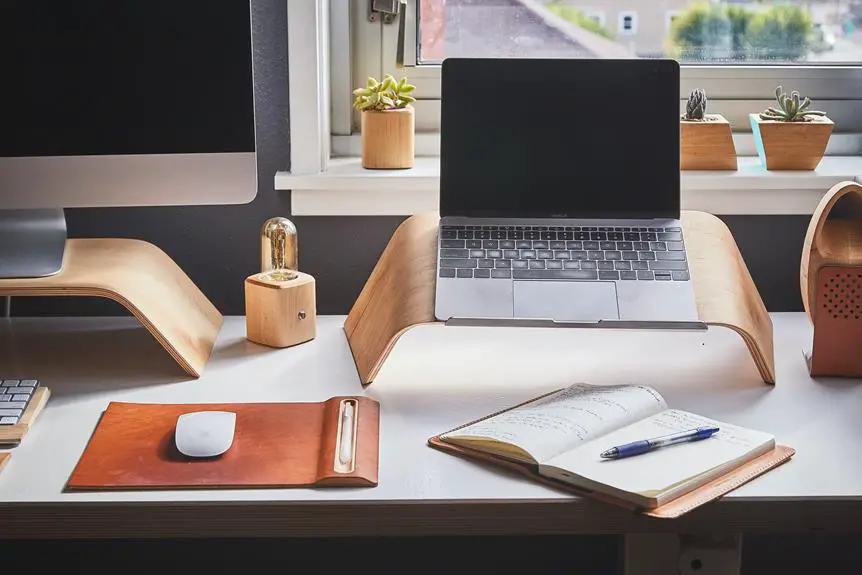In the comfort of your home, the lines between work and personal life can easily blur, especially in your home office. It's where productivity meets distraction, and where boundaries are essential but often overlooked.
But fear not, because establishing clear boundaries in your home office can make all the difference in maintaining a healthy work-life balance. From creating a dedicated workspace to setting communication boundaries, there are several practical steps you can take to reclaim your space and time.
Key Takeaways
- Designate a dedicated workspace that is separate from high-traffic areas and has good natural light.
- Establish clear work hours and communicate them with family members, clients, and colleagues.
- Set communication boundaries by scheduling specific times to check and respond to emails and using work-related communication platforms.
- Create physical barriers within your home office to separate your workspace from the rest of your living space.
Designating a Dedicated Workspace
When setting up your home office, it's crucial to designate a dedicated workspace to create a productive and focused environment. Personalizing your workspace is essential to make it feel like your own. Choose a location with good natural light, a comfortable chair, and a spacious desk that suits your working style. Adding personal touches such as pictures, plants, or inspiring quotes can make the space feel welcoming and motivating.
Minimizing distractions is another key aspect of creating a dedicated workspace. Keep your work area separate from high-traffic areas of your home to reduce interruptions. If possible, choose a room with a door you can close to signal when you need uninterrupted focus. Consider using noise-canceling headphones or a white noise machine to block out any distracting sounds.
Organize your workspace to minimize clutter, keeping only the essentials within reach. This will help you stay focused and avoid getting sidetracked by unnecessary items.
Establishing Clear Work Hours
Setting clear work hours is essential to maintain a healthy work-life balance and ensure productivity in your home office. By setting expectations and avoiding distractions, you can establish clear boundaries and create a conducive work environment for yourself.
Here are some tips to help you establish clear work hours:
- Create a Schedule: Set specific work hours for each day and stick to them as much as possible. This will help you and others in your household understand when you're available for work and when you're not.
- Communicate with Family or Roommates: Discuss your work schedule with your family members or roommates, so they're aware of when you need to focus and minimize interruptions during those times.
- Set Boundaries with Clients or Colleagues: Clearly communicate your work hours to clients or colleagues to manage their expectations regarding your availability. Let them know when they can expect a response from you.
- Limit Personal Tasks During Work Hours: Try to avoid personal tasks or errands during your designated work hours. Save these for breaks or after work to maintain your focus and productivity.
Establishing clear work hours not only helps you manage your time effectively but also allows you to create a healthy separation between your professional and personal life. By being intentional about your work hours, you can reduce distractions and increase your overall productivity.
Setting Communication Boundaries
To establish communication boundaries in your home office, it's important to clearly define when and how you'll be available to communicate with others. One key aspect of this is email etiquette. Set specific times during the day when you'll check and respond to emails. This prevents constant email interruptions, allowing you to focus on your work without distractions. Communicate these designated email times to your colleagues and clients, so they understand when they can expect a response from you.
Family interruptions can also impact your work if communication boundaries aren't set. While working from home, it's crucial to communicate with your family members about your work hours and when you can't be disturbed unless it's an emergency. Establish signals or cues, such as a closed door, to indicate when you shouldn't be interrupted. Consistently reinforcing these boundaries with your family will help create a conducive work environment.
Additionally, consider using tools like instant messaging or project management platforms for work-related communication. This can help separate personal and professional interactions, allowing you to maintain focus during work hours. If you share your home office space with others, communicate your need for uninterrupted work time to minimize distractions.
Creating Physical Barriers
Consider rearranging your home office layout to physically separate your workspace from other areas of your home. Creating physical barriers can help you establish clear boundaries and maintain a productive work environment. Here are some simple yet effective ways to achieve this:
- Privacy Screens: Invest in privacy screens to section off your workspace. These can be portable, foldable screens that you can easily move around as needed. They not only provide visual separation but also help reduce noise and distractions.
- Desk Partitions: If you have an open-concept office space within your home, desk partitions are a great option for creating individual workstations. These partitions can be attached to the desk to create a sense of personal space and minimize visual and auditory disruptions.
- Bookshelves or Cabinets: Strategically placing bookshelves or cabinets around your workspace can act as physical barriers. They not only help to define the boundaries of your office area but also provide additional storage for office supplies and materials.
- Rugs or Floor Mats: Use rugs or floor mats to delineate the boundaries of your home office within a larger room. This simple technique can visually separate your workspace from the rest of the room and create a designated work area.
Implementing Self-Care Practices
Make sure to prioritize your well-being by incorporating self-care practices into your daily routine while working from your home office. Mindfulness breaks and relaxation techniques are essential for maintaining a healthy balance between work and personal life.
Taking short breaks throughout the day to practice mindfulness can help clear your mind, reduce stress, and improve focus. You can try simple breathing exercises or meditation to help center yourself and stay grounded.
In addition to mindfulness breaks, integrating healthy habits into your day is crucial for stress management. Make it a point to schedule regular exercise, whether it's a quick walk outside, yoga, or a home workout. Physical activity not only promotes better physical health but also releases endorphins that can boost your mood and energy levels.
Moreover, pay attention to your nutrition and stay hydrated. Eating balanced meals and staying hydrated can have a significant impact on your overall well-being and productivity. Consider incorporating healthy snacks and water breaks into your work routine.
Lastly, don't underestimate the power of relaxation techniques. Whether it's listening to calming music, practicing deep breathing, or engaging in a hobby you enjoy, finding ways to unwind and relax after work hours is vital for recharging and preventing burnout.
Frequently Asked Questions
How Can I Effectively Communicate My Boundaries to My Family Members or Housemates?
To set expectations with family, communicate your boundaries clearly and respectfully. Discuss the need for uninterrupted work time, designated office space, and quiet hours. Openly share your needs and ask for their support.
What Are Some Strategies for Dealing With Distractions and Interruptions in a Home Office?
To minimize distractions in your home office, set priorities and create a dedicated workspace. Communicate your needs to family members, establish a schedule, and use tools like noise-cancelling headphones. Stay focused and be assertive about your work time.
Is It Important to Set Boundaries for Personal Tasks and Chores During Work Hours?
When you set boundaries for personal tasks during work hours, it helps you stay focused and productive. It's like creating a clear path in a forest, making it easier to navigate and reach your destination efficiently.
How Can I Maintain a Healthy Work-Life Balance While Working From Home?
To maintain a healthy work-life balance while working from home, focus on maintaining a dedicated work area, setting clear work hours, and taking regular breaks. Prioritize tasks, limit distractions, and establish boundaries to manage time effectively.
What Are Some Tips for Creating a Boundary Between Work and Relaxation Spaces in a Home Office?
To maintain work-life balance, designate specific areas for work and relaxation in your home office. Use productivity strategies like time blocking and setting clear start and end times to create boundaries and minimize distractions.





